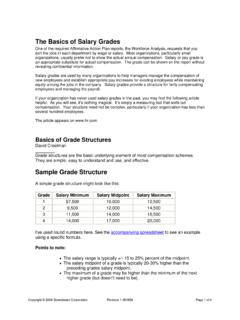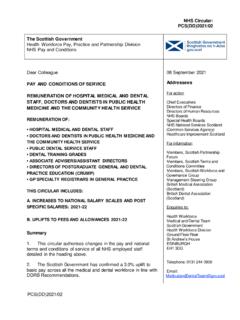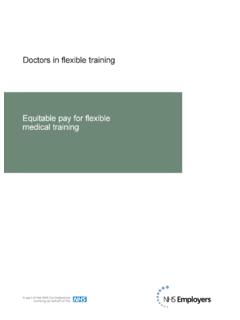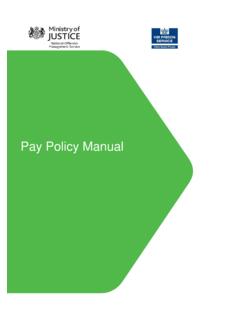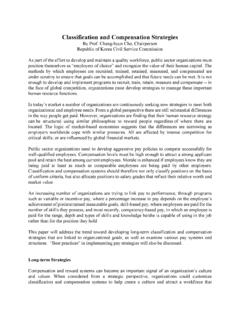Transcription of HR’s Guide to Communicating Compensation - Salary Survey
1 HR s Guide to Communicating Compensation IntroductionPatrick Beall, CCPR ebecca Toman, CCP, CBPD avid Peterson CCPEric TraylorPresentation from WorldatWork Total Rewards Conference in 20112 Agenda Internal and external influences on compensationcommunication approaches Current trends and new techniques forcommunicating Compensation How to communicate a new compensationprogram Results from a recent Survey on compensationcommunication elements A Compensation communication checklist Q&A3 Quick Poll4 Does your organization communicate Compensation information to employees?51%2%24%10%23%26%5%9%Yes, monthlyYes, quarterlyYes, annuallyYes, upon hire,promotion, or job changeYes, during merit deliveryYes on an as neededbasisNoOtherCommunicating Compensation : It Starts With a Strategy All companies must articulate their Compensation communication strategy; considerations include: Align with the business strategy; Supported by the top executive(s); Modeled by the top executive and the executive team.
2 Business objectives of Communicating Compensation typically include: Awareness Motivational Understanding Appreciation Refine and revisit your communication strategy often6 What Compensation Elements to Communicate Compensation philosophy and strategy Pay for performance Risk/reward relationship Competitive pay position/pay mix/peer organizations Base pay Pay strategy Merit policy and timing of increases Salary administration (levels, grades, bands, etc.)7Do employees have access to base Salary range information?818%22%8%39%13%Yes employees know base salaryranges for each gradeYes, or organization only shares thebase Salary range information forthe employee's gradeYes, our organization only sharesthe base Salary range informationfor the employee's grade and thenext higher gradeNoOtherWhat Compensation Elements to Communicate Variable pay Eligibility (who, when, etc.)
3 Objectives, link to business strategy, payout terms Targets, progress, expected payout How program works Equity plan details (vesting, tax implications, etc.) Legally required communication9 Which statements apply to your organization s short-term incentive plans? of organizations do not have a short-term incentive program of employees know their target annual incentive opportunity of employees know the target annual incentive opportunities for other participant tiers of organizations communicate performance related to goals during the plan period of employees clearly understand how incentive plans work10 Example of Short-Term Incentive Communication Performance Progress Dials Updated quarterly Post earnings call Positive response to dials from employees; popular site each quarter Site contains calculator for Performance Sharing, numerous links to learn more about the programs and other related information (dates, etc.)
4 11 Communication Targets Identify the audience: Who are your targets? Managers, supervisors Professionals Salaried, hourly workers Union employees Other segments-Prospective or future employees-Family members of employees-Other employee segments or groups12 Does your organization provide total reward communication training to managers?1335%54%11%YesNoOtherCommunicat ion Channels Face-to-face Meetings Presentations Workshops Paper-based Brochures, booklets Newsletters Letters and memos14 Real-timeinteraction/feedback Verbal and nonverbal information Delivery from trusted source Readat own pace Reference & share with others later ConsistencyBranding Why use HR branding? Using or creating an HR brand complements and supports the corporate/organizational brand to more effectively communicate Compensation programs-Establishes a consistent image-Improves employee attraction and retention-Contributes to a recognizable corporate and employee culture15 Communication Channels Technology-based Websites CD-ROMs E-mails Portals Podcasts Kiosks Video, web conferencing, webcasts16 Delivermessage quickly, conveniently, and in cost effective manner Communicating time-sensitive information Employees search and access data as neededWhat methods are used in your organization to communicate Compensation and/or benefits programs?
5 17020406080100120140 Communication Channels Selection considerations Audience-Location-Culture, language-Preferred method of communication Resources-Cost, budget-Time18 Compensation Communication Frequency/Timing Companies must determine timing of communications for key events and milestones, typically including: Annual ( , focal review) Semi-annual Monthly or quarterly ( , in conjunction with periodic processing of special incentive programs) Ongoing (intranet/ESS portal site with 24/7 access)19 Quick Poll20In the last two years, communication about Compensation at your organization has:2150%7%42%1%IncreasedDecreasedRemain ed constantOtherCompensation Statements Compensation statements illustrate the value of rewards, helping employees to make informed decisions. Characteristics include: Delivered electronically, in-person by managers, or both An introductory statement from a key executive An overview of total Compensation , with charts/tables In many cases, a before and after of focal review results In some cases, all employer contributions Statements can range from a single page to over 10 pages May be developed in-house or with help of an outside vendor22 What information is included in the Total Reward Statement?
6 23020406080100120 Who completes the Total Reward Statements?2449%27%18%6%Human ResourcesstaffPartially outsourcedto a third-partyvendorFully outsourced to athird-party vendorOtherCommunicating a New Program Implementing a new or revised Compensation plan requires ongoing, detailed communication. You ve got to sell the new plan to your employees. ROI on your Compensation program is diminished by sloppy communication develop a structured approach!25A Structured Approach Six Steps Decide who will serve on your communication team and what their role will be Determine your communication objectives and key messages Identify the key audience groups Select the best methods of communication Create a detailed project plan very important! Measure your News in a Down Economy Communicating negative information about Compensation & benefits is a major challenge.
7 Wage freezes Lack of bonus funding Salary reductions Lay-offs Red-circling Reducing 401(k) match Higher employee premiums Discontinuation of certain benefit plans27A Well-crafted Communication Plan will Lessen the Blow Consistent, clear communication will help morale: Who? What? Where? When? Why? Lead with humanity and empathy Communications should address likely questions from employees Finding the right tone is important Give sufficient notice Nobody likes surprises Encourage dialogue!28 Communication Language29 Don Use complicated Compensation terms Express dissatisfaction with the pay or performance decision Say, HR made me do it! Reveal pay or performance of other employees Ensure employee understands the terminology Keep comments on the pay system neutral; explain rationale rather than opinion Explain how pay and performance decisions are made Inform employee where his/her pay stands relative to the target range How Successful is Your Communication Strategy?
8 Evaluation of Compensation communication programs is a continuous process Have you stopped to measure its success? Considerations for evaluating your communication plan: Focus Groups One-on-one interviews with key individuals Surveys Communication metrics30 Communicating Compensation Checklist Set your strategy; establish communication champions Define the elements which need to be communicated Determine how and when you want to communicate Consider population needs/wants: generational, cultural, geographic, etc. Utilize available technology platforms Plan out new program communications carefully Ongoing evaluation of communications strategy is a must31 Questions/Sharing From the Audience32 Manager s Quick Checklist for Face-to-Face Pay Discussion Preparation Schedule face-to-face meetings in a quiet, comfortable, private location Review performance documentation in advance of the meeting; anticipate employee s reaction and prepare accordingly Understand the Company position, philosophy, economic situation, total Compensation mix, etc.
9 Know the details before the meeting begins Conducting the meeting Avoid interruptions and distractions ( , mute phone) Mindset check. Approach the meeting as a meaningful interaction rather than a burden on time Briefly explain purpose of meeting; put employee at ease Own the pay decision. Discuss the decision and explain why we do what we do. Deliver an honest, clear message when celebrating achievements and coaching improvement opportunities. Two-Way Dialogue Listen attentively to the employee, accept feedback and answer questions Ask questions to ensure understanding before providing feedback and constructive suggestions Allow ample time for discussion Commitment to Action Express commitment and support for employee s success Commit to follow-up if questions or concerns can t be resolved during meeting End meeting on a positive note.
10 Saying Thank you is a good start. Focus on next steps and follow up activities33 Seize the opportunity to develop a positive relationship, build mutual respect, and reinforce key points

